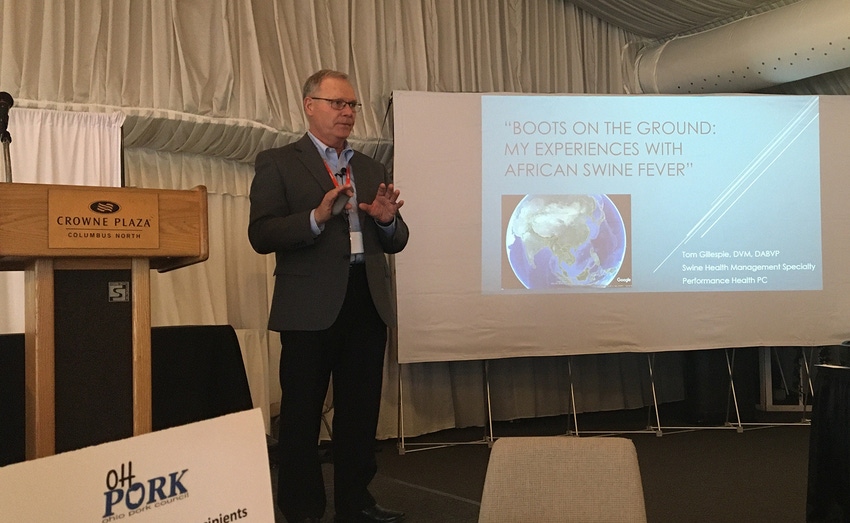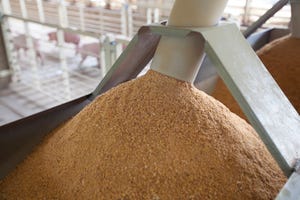Indiana swine veterinarian shares his "boots on the ground" observations since African swine fever hit China.

It's often said a picture is worth a thousand words. Ohio pork producers had the opportunity Wednesday to take home a book full of observations on China's fight against African swine fever after Tom Gillespie's visual presentation at the state's annual pork congress.
"ASF is the enemy and I can't stress that enough on how China, at least the farms that I'm working on routinely, has responded to this challenge," Gillespie says. "It's really a war that they're in, and they have responded accordingly."
A swine veterinarian for more than 40 years and the owner of Performance Health PC, Gillespie has spent his fair share of time outside his home state of Indiana in the Far East. While some of the country's cultural norms are difficult for Westerners to comprehend, there are other areas where the nation has been highly progressive. Gillespie says it has taken him some time to get used to the food (rabbit's head, ruminant stomachs, goose intestines), the sleeping accommodations (a plywood board covered with a comforter) and the ground level toilets, but at the same time he has been amazed with the facial recognition technology, the high-speed trains and the number of luxury cars on the streets.
While he's still seeing some of those cultural norms in Chinese pig production such as backyard pigs, Gillespie says he's also seeing a seismic shift from less mid-size to more intensive production, especially since ASF. To understand the "whys" and "hows" of ASF in China, one has to understand the cultural aspects that have helped transmit this virus around China and southeastern Asian countries.
"The government wants big units so they're wanting to change the industry as we speak and it's changing, it's changing very rapidly," Gillespie says. "Last August I gave a talk to a unit that has 46 sow units today and their goal is to build 50 new units this year."
Now with coronavirus on the human side, in addition to ASF, Gillespie says China is learning very quickly about the importance of biosecurity, but it hasn't been easy battling ASF virus. ASFV is a large enveloped DNA virus with some genotypes being an arbo-DNA virus (tick transmission). There have been 22 genotypes of the ASFV identified and they vary in virulence, with some high virulence strains having an impact of nearly 100% mortality in herds, while others show seroconversion with low mortality rates. The virus can infect monocytes and macrophages.
"I've seen over several weeks, 96% mortality in a finisher barn. There is an incredible variation that occurs with some of the outbreaks," Gillespie says. "It likes to get in white blood cells and red blood cells. One drop of blood can have over 300 copies of this virus, so it proliferates quite a bit."
The environmental persistence is characteristic of ASFV. The virus is resistant and persistent in the environment. Some strains not only survive but also remain infectious across a range of pHs from 4 to 13. Different studies report virulent activity for ASFV strains stored for more than five years at 41 degrees F, for 18 months at 68 degrees F and between 10 to 30 days at 98.6 degrees F. The virus can survive in soils or animal feces for five to six months and up to 30 months in chilled meat.
"I can tell you by March of last year, nobody had had a successful repopulation. First, the producers were trying to quickly react to the initial reporting in August 2018, although it quickly moved around China to depopulating their farms. Depopulation alone created a trying time to get their sites cleaned up. The next step was a struggle in how to repop and stay clean. Their program at that time was to put some sentinel pigs in and see if there was disease or an antibody response," Gillespie says. "Well, I participated in a workshop and one guy had 17,000 sows that he had to depopulate. One of the take homes was three months was not long enough. They had chosen six months and by August last year I heard positive results on repopulation. Reports are starting to show that their sow numbers are coming back a little bit, and that's because they're starting to have some success."
This is just one example Gillespie used to illustrate how Chinese pork producers are willing to make changes and make them fast.
"We were talking about biosecurity and I kept coming back to the rodent program, the bait stations. I said, 'who's in control of that?' 'Well, we hired a firm, they come here four times a year' and I said, 'well, look at the feed that's dribbling out of this auger,'" Gillespie says. "The next day they had temporary plastic bags on the boot of every bin on that farm, a 10,000-sow farm, that's how quick they will respond to make improvements."
Gillespie works with farms in the Guizhou province as well as Chengdu and says some have gone above and beyond on their biosecurity programs since ASF. For instance, one production system he routinely consults for has the means to take much more exhaustive measures.
The first thing they did to their site with 10,000 sows was to put up a perimeter fence, even though there are eight to 10 backyard farms just outside the fence, Gillespie says, which continues to be a cause for concern. They have changed from a bagged feed system to bulk deliveries with trucks filling bulk bins immediately after entering the front gate. There is isolation on site for gilts and boars. They now have in place an intense diagnostic monitoring system for routine and sick animals. A dormitory is on-site for the 115 employees to stay, including four which are chefs who do all the cooking on-site.
To get into the site, Gillespie must spend one-night downtime prior to arrival at the farm. He is then required to take two showers, 10 minutes long each, with farm clothes changed in between and then must spend one more night in isolation and one or two nights in the dormitory before being allowed into production.
"You know what drove this? This firm has the ability to do PCRs. They do lots of PCRs. They broke in August in the country, and by mid-November, they had already determined that the employees that do leave for a week or two, when they come back, they were positive, either their hair, hands or the shoes were positive for ASF," Gillespie says. "Think about that, in just two to three months, it has seeded itself down at people's homes, restaurants, towns, everywhere for the person to be positive coming back to work."
The company is now requiring a daily shower to get into their local headquarters and feed mill which produces 140 million metric tons annually. They are building a new road to separate entry/exit for feed deliveries and are putting up car washes for employees to use before driving into the farm. At the front gates, trucks are now getting washed down with disinfectant. They even have a biosecurity lead person for biosecurity with electronics surveillance in their main "command" room that monitors employee actions through an extensive network of cameras.
While Gillespie questions if some of these actions are sustainable, he says some measures are making a notable difference. For example, the feed mills are heating feed to try to reduce the presence of ASF. The serological results have shown that the biosecurity program is making a difference on other pathogens. At their Sept. 11 and Sept. 22 samplings, besides porcine reproductive and respiratory syndrome diagnostics, other pathogens including classical swine fever, porcine circovirus type 2, toxoplasma, Mycoplasma suis and swine chlamydiosis were tested by polymerase chain reaction. The results indicated the animals on the site were negative for all of the tests.
Gillespie says these changes have been positive to see but the virus is affecting pork, even meat on a global basis. The United States may not feel it, but people are making changes around the world due to ASF, despite cultural norms.
"We can't really ignore the human aspects anymore when it comes to biosecurity," Gillespie says.
About the Author(s)
You May Also Like





